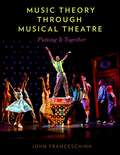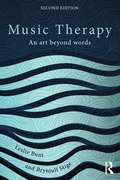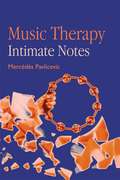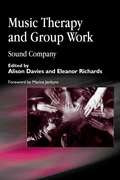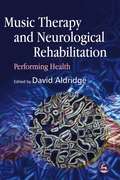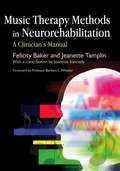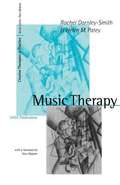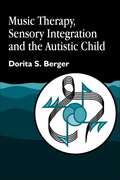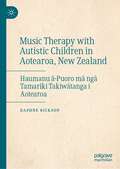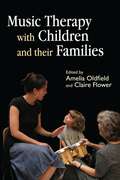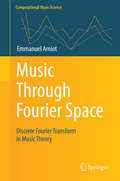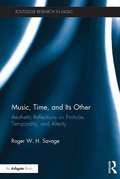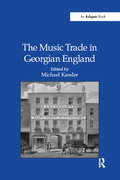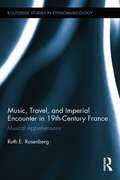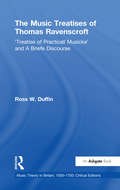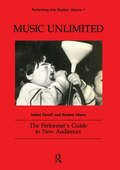- Table View
- List View
MUSIC THEORY THROUGH MUSICAL THEATRE C: Putting It Together
by John FranceschinaMusic Theory through Musical Theatre takes a new and powerful approach to music theory. Written specifically for students in music theatre programs, it offers music theory by way of musical theatre. Not a traditional music theory text, Music Theory through Musical Theatre tackles the theoretical foundations of musical theatre and musical theatre literature with an emphasis on what students will need to master in preparation for a professional career as a performer. Veteran music theatre musician John Franceschina brings his years of experience to bear in a book that offers musical theatre educators an important tool in equipping students with what is perhaps the most important element of being a performer: the ability to understand the language of music in the larger dramatic context to which it contributes. The book uses examples exclusively from music theater repertoire, drawing from well-known and more obscure shows and songs. Musical sight reading is consistently at the forefront of the lessons, teaching students to internalize notated music quickly and accurately, a particularly necessary skill in a world where songs can be added between performances. Franceschina consistently links the concepts of music theory and vocal coaching, showing students how identifying the musical structure of and gestures within a piece leads to better use of their time with vocal coaches and ultimately enables better dramatic choices. Combining formal theory with practical exercises, Music Theory through Musical Theatre will be a lifelong resource for students in musical theatre courses, dog-eared and shelved beside other professional resource volumes.
Music Therapy: An art beyond words (Ashgate Popular And Folk Music Ser.)
by Leslie Bunt Brynjulf StigeMusic therapy is recognised as being applicable to a wide range of healthcare and social contexts. Since the first edition of Music Therapy: An art beyond words, it has extended into areas of general medicine, mainstream education and community practice. This new edition revises the historical and theoretical perspectives and recognises the growing evidence and research base in contemporary music therapy. Leslie Bunt and Brynjulf Stige document the historical evolution of music therapy and place the practice within seven current perspectives: medical, behavioural, psychoanalytical, humanistic, transpersonal, culture-centred and music-centred. No single perspective, individual or group approach is privileged, although the focus on the use of sounds and music within therapeutic relationships remains central. Four chapters relate to areas of contemporary practice across different stages of the lifespan: child health, adolescent health, adult health and older adult health. All include case narratives and detailed examples underpinned by selected theoretical and research perspectives. The final two chapters of the book reflect on the evolution of the profession as a community resource and the emergence of music therapy as an academic discipline in its own right. A concise introduction to the current practice of music therapy around the world, Music Therapy: An art beyond words is an invaluable resource for professionals in music therapy and music education, those working in the psychological therapies, social work and other caring professions, and students at all levels.
Music Therapy: An art beyond words
by Leslie Bunt Brynjulf StigeMusic therapy is recognised as being applicable to a wide range of healthcare and social contexts. Since the first edition of Music Therapy: An art beyond words, it has extended into areas of general medicine, mainstream education and community practice. This new edition revises the historical and theoretical perspectives and recognises the growing evidence and research base in contemporary music therapy. Leslie Bunt and Brynjulf Stige document the historical evolution of music therapy and place the practice within seven current perspectives: medical, behavioural, psychoanalytical, humanistic, transpersonal, culture-centred and music-centred. No single perspective, individual or group approach is privileged, although the focus on the use of sounds and music within therapeutic relationships remains central. Four chapters relate to areas of contemporary practice across different stages of the lifespan: child health, adolescent health, adult health and older adult health. All include case narratives and detailed examples underpinned by selected theoretical and research perspectives. The final two chapters of the book reflect on the evolution of the profession as a community resource and the emergence of music therapy as an academic discipline in its own right. A concise introduction to the current practice of music therapy around the world, Music Therapy: An art beyond words is an invaluable resource for professionals in music therapy and music education, those working in the psychological therapies, social work and other caring professions, and students at all levels.
Music Therapy: Intimate Notes
by Mercedes PavlicevicThe stories and reflections in this book describe powerful encounters between nine music therapists and their clients. These clients include four-year-old Giorgios, who is terminally ill; Wendy, a passionate, battered child who has been rejected by her mother; Olive, suffering from senile dementia; Martha, whose successful life is in crisis; and Steve, who is living with HIV/AIDS. Through music therapy the clients - and therapists - discover their creativity, and, in the process, come to terms with suffering. The stories reveal the passion and integrity of nine music therapists who themselves undergo profound changes as a result of their work. Music Therapy - Intimate Notes is a practical and inspiring introduction to music therapy, showing its range of possibilities in various settings. The book provides a lively and informal theoretical foundation, and connects music to our intimate lives.
Music Therapy and Group Work: Sound Company (PDF)
by Alison Davies Amelia Oldfield Elaine Streeter Eleanor Richards Julie Sutton Tessa Watson'The fascinating and diverse descriptions contained in this text begin the process of developing indigenous understandings of music therapy in group work and alert the reader to issues for future exploration. A fascinating text, describing a range of clients - I highly recommend it.' - Nordic Journal of Music Therapy Group music therapy has been widely practised for many years, especially within institutional settings, and features substantially in training, yet there has been no publication devoted to the discussion of this area of therapy. Music Therapy and Group Work fills this gap by bringing together the experiences of group music therapy practitioners who work with diverse client groups in various settings. Whilst acknowledging that the practice of group music therapy incorporates many theoretical and practical issues in common with those of mainstream group work, the editors emphasize that this field needs to develop some further theoretical discourse of its own, primarily because its main contrast from regular group work is that it draws on a non-verbal medium alongside the ordinary verbal exchange. The book combines clinical examples with theory to provide a comprehensive introduction to group music therapy. Practitioners not only of music therapy, but also those working in related disciplines, will find this to be an informative and stimulating read.
Music Therapy and Neurological Rehabilitation: Performing Health (PDF)
by Anke Scheel-Sailer David Aldridge Hanne Mette Ridder Ochsner Simon GilbertsonThe central tenet of this innovative collection is that identity can be regarded as a performance, achieved through and in dialogue with others. The authors show that where neuro-degenerative disease restricts movement, communication and thought processes and impairs the sense of self, music therapy is an effective intervention in neurological rehabilitation, successfully restoring the performance of identity within which clients can recognise themselves. It can also aid rehabilitation of clients affected by dementia, traumatic brain injury, and multiple sclerosis, among other neuro-generative diseases. Music Therapy and Neurological Rehabilitation is an authoritative and comprehensive text that will be of interest to practising music therapists, students and academics in the field.
Music Therapy Methods in Neurorehabilitation: A Clinician's Manual
by Barbara L Wheeler Felicity Baker Jeanette Kennelly Jeanette TamplinThe value of music therapy in neurological rehabilitation is increasingly recognised and this practical manual provides comprehensive guidance for clinicians on the application of music therapy methods in neurorehabilitation. Felicity Baker and Jeanette Tamplin combine research findings with their own clinical experience and present step-by-step instructions and guidelines on how to implement music therapy techniques for a range of therapeutic needs. Photographs clearly illustrate interventions for physical rehabilitation, for example through the use of musical instruments to encourage targeted movement. The chapter on cognitive rehabilitation includes resources and lists suitable songs for use in immediate memory or abstract thinking tasks, among others. In her chapter on paediatric patients, Jeanette Kennelly demonstrates how procedures can be adapted for working clinically with children. A comprehensive list of terminology commonly used in neurological rehabilitation is also included. Music Therapy Methods in Neurorehabilitation will prove an invaluable reference book for music therapy clinicians and students. It is also suitable for work with other populations, in particular for work in special education.
Music Therapy Methods in Neurorehabilitation: A Clinician's Manual (PDF)
by Barbara L Wheeler Felicity Baker Jeanette Kennelly Jeanette TamplinThe value of music therapy in neurological rehabilitation is increasingly recognised and this practical manual provides comprehensive guidance for clinicians on the application of music therapy methods in neurorehabilitation. Felicity Baker and Jeanette Tamplin combine research findings with their own clinical experience and present step-by-step instructions and guidelines on how to implement music therapy techniques for a range of therapeutic needs. Photographs clearly illustrate interventions for physical rehabilitation, for example through the use of musical instruments to encourage targeted movement. The chapter on cognitive rehabilitation includes resources and lists suitable songs for use in immediate memory or abstract thinking tasks, among others. In her chapter on paediatric patients, Jeanette Kennelly demonstrates how procedures can be adapted for working clinically with children. A comprehensive list of terminology commonly used in neurological rehabilitation is also included. Music Therapy Methods in Neurorehabilitation will prove an invaluable reference book for music therapy clinicians and students. It is also suitable for work with other populations, in particular for work in special education.
Music Therapy (PDF)
by Rachel Darnley-SmithThis book is a detailed introduction to music therapy, and should be of particular interest to intending students of the subject and those wishing to pursue a career within the profession. It should be of considerable use to all with a general interest in the subject as well those making a career on music therapy' - The Organ I found this a useful book in terms of its clarity and carefully thought out structure. It is a rich source of information and of ideas which are extremely important for the potential music therapy trainee to think about; it also makes valuable reading for more experienced therapists, bringing our minds back to some central questions about the nature of our work.. Whatever stage you may be at in your life as a music therapist, it will refresh your mind and your practice' - Eleanor Richards, Nordic Journal of Music Therapy From the Foreword: Rachel Darnley-Smith and Helen M Patey have managed so well to tell their story of music therapy offering the framework of theory, training and professional practice, and the complimentary value of Analytical Music Therapy and Creative Music Therapy within improvization.
Music Therapy, Sensory Integration and the Autistic Child
by Dorita S. BergerMusic's ability to influence emotions and moods is universally acknowledged, and music therapists have long known that stimulating the brain through the auditory system is a key to obtaining remarkable responses. Music therapy is a particularly effective tool when working with children with autism spectrum conditions, because music communicates with these children on a level where mere words cannot go. Written in a way that is both informative for the professional and accessible for parents, this book furthers the already strong case for the use of music therapy as a resource to encourage behavioural changes for the better in children with autism spectrum conditions. Placing particular emphasis upon sensory integration, the author discusses contributing factors to the behaviour of people on the autism spectrum, and, through the use of case studies, presents the latest approaches in music therapy that are enabling children with autism spectrum conditions to better cope with sensory integration.
Music Therapy, Sensory Integration and the Autistic Child (PDF)
by Dorita S. BergerMusic's ability to influence emotions and moods is universally acknowledged, and music therapists have long known that stimulating the brain through the auditory system is a key to obtaining remarkable responses. Music therapy is a particularly effective tool when working with children with autism spectrum conditions, because music communicates with these children on a level where mere words cannot go. Written in a way that is both informative for the professional and accessible for parents, this book furthers the already strong case for the use of music therapy as a resource to encourage behavioural changes for the better in children with autism spectrum conditions. Placing particular emphasis upon sensory integration, the author discusses contributing factors to the behaviour of people on the autism spectrum, and, through the use of case studies, presents the latest approaches in music therapy that are enabling children with autism spectrum conditions to better cope with sensory integration.
Music Therapy with Autistic Children in Aotearoa, New Zealand: Haumanu ā-Puoro mā ngā Tamariki Takiwātanga i Aotearoa
by Daphne RicksonIn this unique text, ten cases of music therapy with autistic children (tamariki takiwātanga) are critiqued through the eyes of family members and other autism experts. Rickson uses her wealth of experience to contextualise their rich observations in a thorough review of research and practice literature, to illustrate the ways music therapists engage autistic children in the music therapy process, highlight the various ways music therapy can support their health and well-being, and demonstrate how music therapy processes align with good practice as outlined in the New Zealand Autism Spectrum Disorder Guideline.
Music Therapy with Children and their Families
by Tiffany Hughes Emma Davies Vince Hesketh Rachel Bull Nicky O'Neill Joy Hasler Kay Sobey Sarah Russel Helen Loth Claire Flower Jassenka Horvat Colette Salkeld Amelia OldfieldIn the past, music therapy work with children typically took place in special schools without the family being present. More recently, music therapy has become a widespread practice, and this book reflects the variety of settings within which music therapists are now working with children together with their families. The contributors are music therapists with experience of working with children and their families in a range of different environments, such as schools, hospices, psychiatric units, child development centres and in the community. They describe their approaches to family work with client groups including children with autism, learning disabled toddlers, adopted children and looked after teenagers. Their experiences demonstrate that involving the family in a child's music therapy can be beneficial for everyone, and that it is possible to address relationship issues within the family as part of the treatment. This book will provide useful insight into the growing area of music therapy with children and their families, and will be valuable for music therapy professionals and students, as well as other medical and teaching professionals who work with families.
Music Therapy with Children and their Families (PDF)
by Amelia Oldfield Claire Flower Colette Salkeld Emma Davies Helen Loth Jassenka Horvat Joy Hasler Kay Sobey Nicky O'Neill Rachel Bull Sarah Russel Tiffany Hughes Vince HeskethIn the past, music therapy work with children typically took place in special schools without the family being present. More recently, music therapy has become a widespread practice, and this book reflects the variety of settings within which music therapists are now working with children together with their families. The contributors are music therapists with experience of working with children and their families in a range of different environments, such as schools, hospices, psychiatric units, child development centres and in the community. They describe their approaches to family work with client groups including children with autism, learning disabled toddlers, adopted children and looked after teenagers. Their experiences demonstrate that involving the family in a child's music therapy can be beneficial for everyone, and that it is possible to address relationship issues within the family as part of the treatment. This book will provide useful insight into the growing area of music therapy with children and their families, and will be valuable for music therapy professionals and students, as well as other medical and teaching professionals who work with families.
Music Through Fourier Space: Discrete Fourier Transform in Music Theory (Computational Music Science)
by Emmanuel AmiotThis book explains the state of the art in the use of the discrete Fourier transform (DFT) of musical structures such as rhythms or scales. In particular the author explains the DFT of pitch-class distributions, homometry and the phase retrieval problem, nil Fourier coefficients and tilings, saliency, extrapolation to the continuous Fourier transform and continuous spaces, and the meaning of the phases of Fourier coefficients. This is the first textbook dedicated to this subject, and with supporting examples and exercises this is suitable for researchers and advanced undergraduate and graduate students of music, computer science and engineering. The author has made online supplementary material available, and the book is also suitable for practitioners who want to learn about techniques for understanding musical notions and who want to gain musical insights into mathematical problems.
Music, Time, and Its Other: Aesthetic Reflections on Finitude, Temporality, and Alterity (Routledge Research in Music)
by Roger W. SavageMusic, Time, and Its Other explores the relation between the enigmatic character of our temporal experiences and music’s affective power. By taking account of competing concepts of time, Savage explains how music refigures dimensions of our experiences through staking out the borderlines between time and eternity. He examines a range of musical expressions that reply to the deficiency born from the difference between time and an order that exceeds or surpasses it and reveals how affective tonalities of works by Bach, Carolan, Debussy, Schoenberg, Messiaen, and Glass augment our understanding of our temporal condition. Reflections on the moods and feelings to which music gives voice counterpoint philosophical investigations into the relation between music’s power to affect us and the force that the present has with respect to the initiatives we take. Music, Time, and Its Other thus sets out a new approach to music, aesthetics, politics, and the critical roles of judgment and imagination.
Music, Time, and Its Other: Aesthetic Reflections on Finitude, Temporality, and Alterity (Routledge Research in Music)
by Roger W. SavageMusic, Time, and Its Other explores the relation between the enigmatic character of our temporal experiences and music’s affective power. By taking account of competing concepts of time, Savage explains how music refigures dimensions of our experiences through staking out the borderlines between time and eternity. He examines a range of musical expressions that reply to the deficiency born from the difference between time and an order that exceeds or surpasses it and reveals how affective tonalities of works by Bach, Carolan, Debussy, Schoenberg, Messiaen, and Glass augment our understanding of our temporal condition. Reflections on the moods and feelings to which music gives voice counterpoint philosophical investigations into the relation between music’s power to affect us and the force that the present has with respect to the initiatives we take. Music, Time, and Its Other thus sets out a new approach to music, aesthetics, politics, and the critical roles of judgment and imagination.
The Music Trade in Georgian England
by Michael KasslerIn contrast to today's music industry, whose principal products are recorded songs sold to customers round the world, the music trade in Georgian England was based upon London firms that published and sold printed music and manufactured and sold instruments on which this music could be played. The destruction of business records and other primary sources has hampered investigation of this trade, but recent research into legal proceedings, apprenticeship registers, surviving correspondence and other archived documentation has enabled aspects of its workings to be reconstructed. The first part of the book deals with Longman & Broderip, arguably the foremost English music seller in the late eighteenth century, and the firm's two successors - Broderip & Wilkinson and Muzio Clementi's variously styled partnerships - who carried on after Longman & Broderip's assets were divided in 1798. The next part shows how a rival music seller, John Bland, and his successors, used textual and thematic catalogues to advertise their publications. This is followed by a comprehensive review of the development of musical copyright in this period, a report of efforts by a leading inventor, Charles 3rd Earl Stanhope, to transform the ways in which music was printed and recorded, and a study of Georg Jacob Vollweiler's endeavour to introduce music lithography into England. The book should appeal not only to music historians but also to readers interested in English business history, publishing history and legal history between 1714 and 1830.
The Music Trade in Georgian England
by Michael KasslerIn contrast to today's music industry, whose principal products are recorded songs sold to customers round the world, the music trade in Georgian England was based upon London firms that published and sold printed music and manufactured and sold instruments on which this music could be played. The destruction of business records and other primary sources has hampered investigation of this trade, but recent research into legal proceedings, apprenticeship registers, surviving correspondence and other archived documentation has enabled aspects of its workings to be reconstructed. The first part of the book deals with Longman & Broderip, arguably the foremost English music seller in the late eighteenth century, and the firm's two successors - Broderip & Wilkinson and Muzio Clementi's variously styled partnerships - who carried on after Longman & Broderip's assets were divided in 1798. The next part shows how a rival music seller, John Bland, and his successors, used textual and thematic catalogues to advertise their publications. This is followed by a comprehensive review of the development of musical copyright in this period, a report of efforts by a leading inventor, Charles 3rd Earl Stanhope, to transform the ways in which music was printed and recorded, and a study of Georg Jacob Vollweiler's endeavour to introduce music lithography into England. The book should appeal not only to music historians but also to readers interested in English business history, publishing history and legal history between 1714 and 1830.
Music, Travel, and Imperial Encounter in 19th-Century France: Musical Apprehensions (Routledge Studies in Ethnomusicology)
by Ruth RosenbergThis book considers the activities and writings of early song collectors and proto-ethnomusicologists, memoirists, and other "musical travelers" in 19th-century France. Each of the book’s discrete but interrelated chapters is devoted to a different geographic and discursive site of empire, examining French representations of musical encounters in North America, the Middle East, as well as in contested areas within the borders of metropolitan France. Rosenberg highlights intersections between an emergent ethnographie musicale in France and narratives of musical encounter found in French travel literature, connecting both phenomena to France’s imperial aspirations and nationalist anxieties in the period from the Revolution to the late-nineteenth century. It is therefore an excellent research tool for scholars in the fields of ethnomusicology, musicology, cultural studies, literary history, and postcolonial studies.
Music, Travel, and Imperial Encounter in 19th-Century France: Musical Apprehensions (Routledge Studies in Ethnomusicology)
by Ruth RosenbergThis book considers the activities and writings of early song collectors and proto-ethnomusicologists, memoirists, and other "musical travelers" in 19th-century France. Each of the book’s discrete but interrelated chapters is devoted to a different geographic and discursive site of empire, examining French representations of musical encounters in North America, the Middle East, as well as in contested areas within the borders of metropolitan France. Rosenberg highlights intersections between an emergent ethnographie musicale in France and narratives of musical encounter found in French travel literature, connecting both phenomena to France’s imperial aspirations and nationalist anxieties in the period from the Revolution to the late-nineteenth century. It is therefore an excellent research tool for scholars in the fields of ethnomusicology, musicology, cultural studies, literary history, and postcolonial studies.
The Music Treatises of Thomas Ravenscroft: 'Treatise of Practicall Musicke' and A Briefe Discourse
by RossW. DuffinThomas Ravenscroft is best-known as a composer of rounds owing to his three published collections: Pammelia and Deuteromelia (both 1609), and Melismata (1611), in addition to his harmonizations of the Whole Booke of Psalmes (1621) and his original sacred works. A theorist as well as a composer and editor, Ravenscroft wrote two treatises on music theory: the well-known A Briefe Discourse (1614), and 'A Treatise of Practicall Musicke' (c.1607), which remains in manuscript. This is the first book to bring together both theoretical works by this important Jacobean musician and to provide critical studies and transcriptions of these treatises. A Briefe Discourse furthermore introduces an anthology of music by Ravenscroft, John Bennet, and Ravenscroft's mentor, Edward Pearce, illustrating some of the precepts in the treatise. The critical discussion provided by Duffin will help explain Ravenscroft's complicated consideration of mensuration, in particular.
The Music Treatises of Thomas Ravenscroft: 'Treatise of Practicall Musicke' and A Briefe Discourse (Music Theory In Britain, 1500-1700: Critical Editions Ser.)
by RossW. DuffinThomas Ravenscroft is best-known as a composer of rounds owing to his three published collections: Pammelia and Deuteromelia (both 1609), and Melismata (1611), in addition to his harmonizations of the Whole Booke of Psalmes (1621) and his original sacred works. A theorist as well as a composer and editor, Ravenscroft wrote two treatises on music theory: the well-known A Briefe Discourse (1614), and 'A Treatise of Practicall Musicke' (c.1607), which remains in manuscript. This is the first book to bring together both theoretical works by this important Jacobean musician and to provide critical studies and transcriptions of these treatises. A Briefe Discourse furthermore introduces an anthology of music by Ravenscroft, John Bennet, and Ravenscroft's mentor, Edward Pearce, illustrating some of the precepts in the treatise. The critical discussion provided by Duffin will help explain Ravenscroft's complicated consideration of mensuration, in particular.
Music Unlimited: The Performer's Guide to New Audiences (Performing Arts Studies)
by Isabel Farrell Kenton MannThis book is designed to be a music performer's companion, informing the performer's decisions as they prepare performances. It describes some of the situations in which performers will find themselves and also the techniques which work for performers while performing in community venues.
Music Unlimited: The Performer's Guide to New Audiences (Performing Arts Studies #Vol. 1)
by Isabel Farrell Kenton MannThis book is designed to be a music performer's companion, informing the performer's decisions as they prepare performances. It describes some of the situations in which performers will find themselves and also the techniques which work for performers while performing in community venues.
